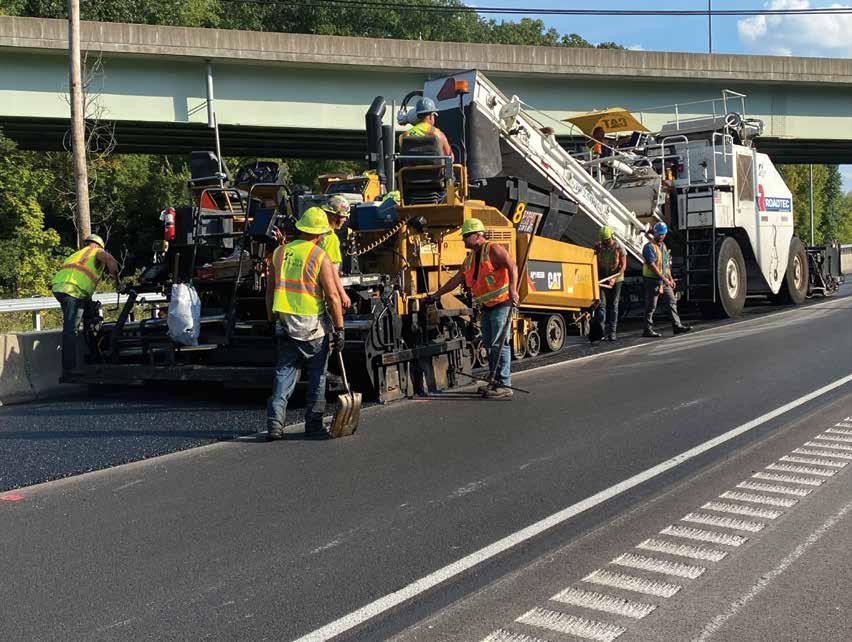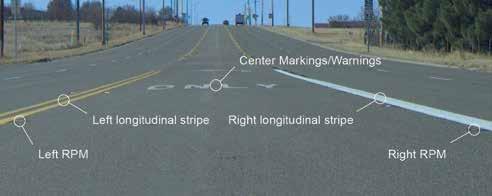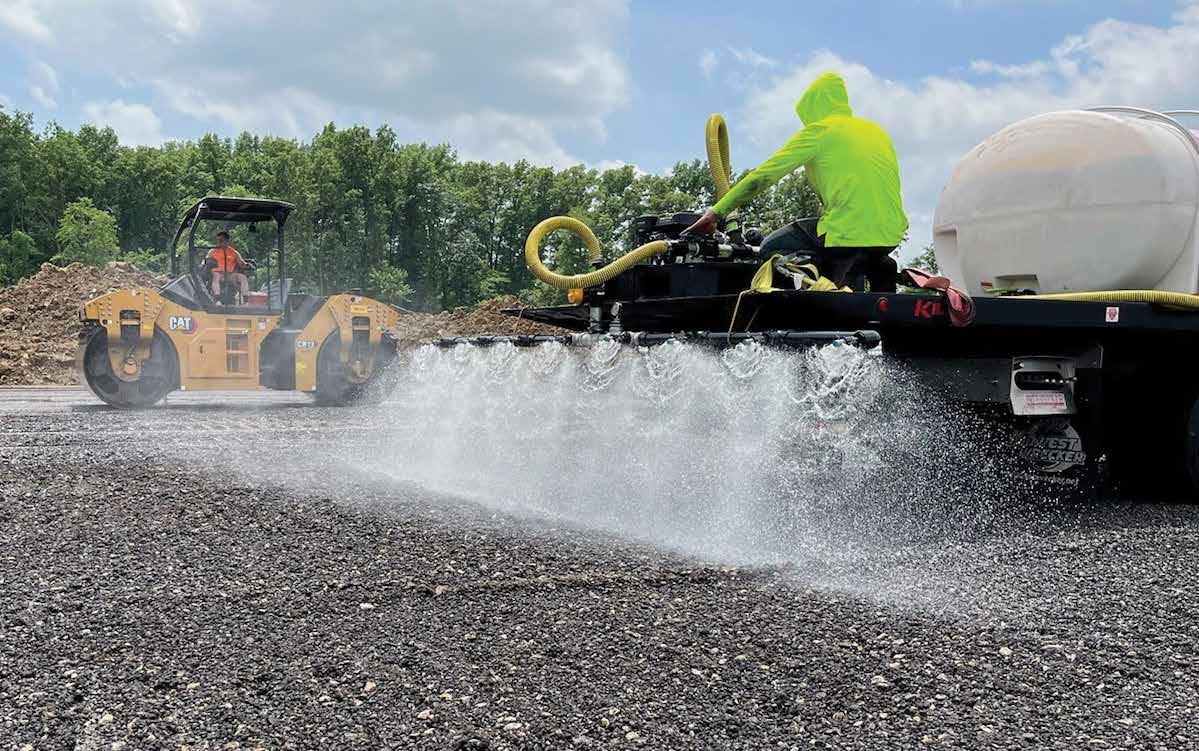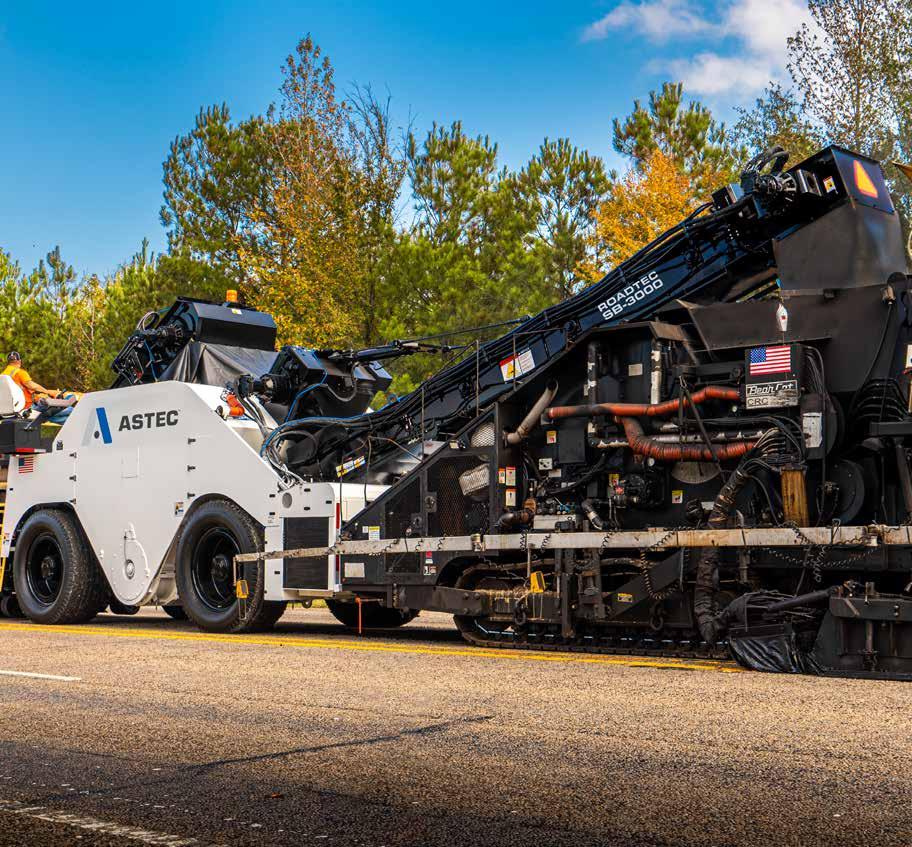
9 minute read
CIR Project Sets Northeast Standard
A host of state and agency materials engineers joined Peckham Industries Inc., Astec Industries, The Gorman Group, Suit-Kote Corporation and Tracey Road Equipment for two days of classroom sessions and outdoor demonstrations to learn more about the cold in-place recycling process at the April 4 and 5 project for the Town of Kingsbury. All photos courtesy of Peckham Industries Inc.
BY SANDY LENDER
Management at Peckham Industries Inc. (PII), headquartered in Brewster, New York, has given the asphalt industry a blueprint on how to showcase an environmentally friendly pavement maintenance method to multiple state agencies. Upon winning the bid for a cold in-place recycling (CIR) project for the Town of Kingsbury to rehabilitate Mattison Road, PII teamed up with industry partners and vendors to put on more than a demonstration. They wanted to educate and inform with two days of classroom sessions and field demos on the intricacies of CIR.
Gregory Peckham, general manager of Peckham Road Corporation (PRC), a PII subsidiary, explained they reached out to Astec Industries, Chattanooga; The Gorman Group, Albany, New York; and SuitKote Corporation, Cortland, New York, to bring the parties together not only for the coordination of the event but also to expand the reach of the learning experience across multiple geographies. That expansion began almost immediately when Eric Baker and Kyle Hammon at Astec reached out to Stephen Cross, Ph.D., P.E., who is the current technical director of the Asphalt Recycling and Reclaiming Association (ARRA) and professor emeritus at Oklahoma State University’s College of Engineering, Architecture, and Technology, to participate as well. Tracey Road Equipment in East Syracuse, a distributor for Astec, also participated and provided lunch between the field demo the morning of April 5 and final informational sessions that afternoon.
Astec’s Hammon explained that attendees benefiting from the educational event included engineers from state departments of transportation (DOT) throughout the northeast, including Maine, New Hampshire and Vermont. The education itself was geared toward all facets of the CIR process.
“The contractor members of the seminar wanted to ensure a portion of it was devoted to lab testing,” Hammon said. He spoke highly of PII’s initiative.
“I give credit to the contractors,” Hammon said. “They did the heavy lifting. Gary Foux at Suit-Kote got the venue.”
The venue used for the classes prior to the outdoor demo was the Kingsbury Firehouse, located near the job. The team from Suit-Kote was unavailable for comment on the project, but Hammon described the venue as perfectly located and ideal for their needs.
Peckham explained the project was quoted using a New York State Office of General Services (NYS OGS) contract. This system allows state agencies, public authorities, local governments or political subdivisions, and volunteer organizations, among others, to procure work as autho-

The Peckham Road Corporation team placed the recycled material in a windrow behind the RX-900e for pickup and paving.
A nurse truck and water truck deliver additives to the blending chamber in this cold in-place recycling (CIR) operation.


rized users in three contract types or categories—commodity, service, and technology. With an authorized user identification number in this system, entities can provide assurances to companies that they are eligible to use state contracts and streamline projects with a purchase order rather than filing copious amounts of paperwork. (Source: https://ogs.ny.gov/procurement/ogs-centralized-contracts)
The CIR project fit nicely in the technology category and the education began with informational sessions. The presentations April 4 and 5 included key components of the process but were not limited to: • Depth(s) of recycling • Metering of materials • Material sizing, plus the effects of add stone and the effects of cement • Production speeds • Temperature limits • How terrain and road conditions influence the process and how sensors can assist, plus the ideal project size and terrain • Accounting for fluff factor in CIR • Cross slope • Performing shoulder repairs • Drainage and water considerations for the CIR project • Performing CIR at night
Drum mixers

www.tarmacinc.com

contact tarmac at 816-220-0700 or info@tarmacinc.com
Peckham explained that much of the quality control/quality assurance (QC/QA) discussions during the seminar portions of the event were handled by ARRA’s Cross.
“My first presentation covered the basics, such as sustainability, cost effectiveness, project selection and assessment, and a few topics of interest to New York—weather, fog seals, slope and grade corrections, and smoothness,” Cross shared. “My second presentation covered mix design and the use of add stone plus an overview of performance studies and current research activities.”
Cross’s presentation explained—among other things—to the audience that CIR is meant to treat non-load associated distresses, also called functional failures, and most structural distresses that occur in the top 2 to 5 inches of the pavement structure. That means, it can be used to mitigate transverse or reflective cracking if the agency selects the road in need of this treatment at the correct stage in its life cycle.
In other words, follow the mantra of selecting the right method for the right road at the right time. Considering Hudson Falls had the right road with the right underlying conditions, the team was on track to perform the right treatment with CIR.
Let’s take a look at the mix design, with guidance from Cross, and the recycling train, with guidance from both Astec and the Federal Highway Administration’s (FHWA) “CIR Application Checklist.”
That’s right: Even though CIR requires an in-place recycling and paving train, it incorporates a mix design. This is required to determine the optimum recycling agent rate and the optimum dosage of additive to be used, whether that’s a corrective aggregate, hydrated lime, Portland cement, and so on.
Cross presented, if a contractor will be using an emulsion as the recycling agent, they will follow AASHTO PP 86 & MP 31 for emulsified asphalt. If using a foamed asphalt as the recycling agent, they will follow AASHTO PP 94 & MP 38 for foamed asphalt. Tests to perform include, but won’t necessarily be limited to, the indirect tensile strength, tensile strength ratio (TSR), Marshall stability, and retained stability. If using the emulsion method, you’ll want to perform a raveling test and possibly a high temperature evaluation. Again, the point is to optimize your results with the design.
Cross’s presentation showed the contractor wants the mix design to establish four things: • An acceptable range of binder contents with expected changes in RAP gradation; • The need for additives for dry strength; • The need for additives to improve moisture resistance; and • The need for high early strength.
For the demonstration on Mattison Road, the PRC crew used the foamed method. “We used a foam process for the demo supplied by our Athens, New York, terminal,” Peckham shared.
The team from Astec presented information on the CIR “train,” which can be as simplistic as a single-unit train or as robust as a multi-unit train, which incorporates the following: 1. A water truck, which feeds into 2. A cold planer/milling machine, which feeds millings onto 3. A screen deck, which sifts material into 4. The pugmill, where a nurse truck delivers emulsion and where mixing occurs before material is delivered to 5. Either a windrow for a pickup device or directly to a paver to be placed under the screed.
Both trains will be followed by a steel drum breakdown roller and pneumatic roller (or two).
As you can see in the pictures on these pages, the PRC team used a water truck and nurse truck to deliver additives to the mixing chamber of the RX-900e from Astec, which milled a depth of 4 inches.
The RX-900e cold planer can be equipped with a skid-mounted additive package, which is mounted to the rear of the milling machine and includes an integrated pump/meter package, automated flush system, and electric over hot oil heating system to facilitate delivering additive materials to the blending chamber. The system includes additive system controls within a control panel allowing the operator to meter up to three additive materials.
The recycled material was placed behind the RX-900e in a windrow for PRC’s Cedarapids’ MS2 pickup machine to feed it to a Caterpillar AP-

When placing and compacting cold-recycled material, the focus will be on achieving density, not on measuring air voids. PRC’s Greg Peckham shared, “The average density is typically about 132 pounds per cubic foot.” To achieve this goal to rehabilitate Mattison Road, the crew used two 12-ton steel rollers and a 20ton pneumatic roller in the compaction train behind the Cat paver, which was fed by an MS2 pickup machine.
The RX-900e cold planer from Astec Industries can be equipped with a skid-mounted additive package, which includes an integrated pump/meter package, automated flush system, and electric over hot oil heating system to facilitate delivering additive materials to the blending chamber.

1055F paver for laydown. “The average density is typically about 132 pounds per cubic foot, and we use two 12-ton steel rollers and a 20-ton pneumatic roller to achieve it,” Peckham shared.
For CIR projects, density is the focus rather than air voids. The agency and inspectors will be interested in density achieved and time for curing to ensure moisture is removed. For this successful demonstration project, Peckham explained the road was paved two weeks later with no issues.
“They did a fantastic job,” Peckham said of his team. “We really lucked out with temperatures on that day of construction and the crew performed beautifully for a season start-up job.”
With a host of state and agency materials engineers on hand to learn from two days of classroom presentations and outdoor demonstrations, the Peckham family brought about an example of industry cooperation for training. Not only did the contractors in the region come together to showcase an environmentally friendly asphalt recycling practice, but they also did it in a spirit of industry advancement.
LEARN MORE
Peckham Industries Goes First with More Green Ideas
The Road Forward initiative of the National Asphalt Pavement Association (NAPA) welcomed its first two funding partners in May. The inaugural sponsors are producer member Peckham Industries Inc. (PII) and associate member Cargill Asphalt Solutions.
A NAPA member since 1973, PII produces hot-, warm-, and cold-mix asphalt in New York, Vermont, and Massachusetts. A NAPA member since 2016, Cargill offers a line of asphalt additives including rejuvenators, warm- and cold-mix additives, and anti-strip to help producers increase performance and profits.
“Peckham Industries is excited to take part in The Road Forward and join NAPA on their journey to a net zero future,” said Will Hadeka, sustainability lead for PII. “Since 1924, our company’s foundation has been built on family values, and we are committed to building a sustainable future for our employees, customers, and communities for generations to come. The Road Forward allows us to unite across the country to help move our industry forward as we pave the way to a sustainable future.” "Cargill provides sustainable asphalt technologies and solutions around the world, and we are on board with NAPA to help advance environmental stewardship in the asphalt industry through The Road Forward initiative,” said Justin Black, Cargill Asphalt Solutions category leader.
“Cargill and Peckham’s foresight in sustainability is an example for our industry and our customers— DOTs and road owners,” remarked NAPA President & CEO Audrey Copeland, PhD, PE.










